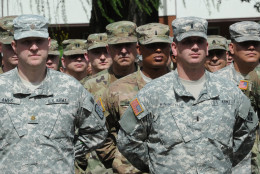Service members of color face racial harassment, safety issues and more, study says
Minorities in the military are experiencing racism from their local communities, racial profiling from law enforcement and slurs from fellow service members, ac...
Minorities in the military are experiencing racism from their local communities, racial profiling from law enforcement and slurs from fellow service members, according to a first-of-its-kind survey that takes a deep dive into the experiences of service members of color and their families.
The study provides new insights into a workforce that is, in large part, a microcosm of American society in terms of representation.
The 14-month Blue Star Families report focused on diversity and inclusion surveyed more than 2,700 respondents about their experience as minorities in the military. The results show racism in and outside the ranks, as well as service members missing opportunities because of race.
“A big part of this is to first recognize you have a problem in the military. The survey really helps with that,” Tom Bostick, former chief of the Army Corps of Engineers and former leader of Army Recruiting Command, told reporters Wednesday. “One of the things that department talks about is being colorblind, that’s probably not the best choice of words for and organization that values diversity. We ought to value the color that’s in our ranks. We need to understand that if there’s a challenge, to any one of those groups, then we have an issue.”
More than half of the respondents said that they felt the colorblind mentality erases part of their identity. It is clear from the survey alone that race is a factor in the military. Sixty-five percent of Black active duty respondents reported hearing racist comments or jokes and 57% of all respondents reported them.
“I’ve heard garrison commanders say racial inequality doesn’t exist in the Army. Changes need to come from changes to the very basis of the military culture,” one respondent wrote.
The Army’s top enlisted officer acknowledged this in 2020 after going on a listening tour about race.
“In one of my listening sessions one of the soldiers said ‘When you say, “All I see is green” you don’t see all of me,’” Sgt. Maj. Michael Grinston, said. “The soldier said ‘You don’t see when I take off my uniform and I go out that gate that people will treat me differently because of the color of my skin. You can’t see that when I go home that I’ve had a gun to my head 13 times since I’ve been in the Army.’”
About one in three active duty service members reported experiencing threats or harassment from local or military police in the last two years. Those reports were most prevalent from Black service members.
“I’ve had police come and remove me from a ‘colonel and above’ parking spot when I was a two-star general,” Bostick, who is Black and Japanese-American, said. “I worry about those much more junior who don’t have that general placard in their car.”
A third of service members and their families surveyed also reported at least one incident of being threatened or harassed by their civilian or military community in the last two years.
Respondents pointed out things like Confederate flags and QAnon flags hanging in neighbors’ garages and coded language as ways they felt discrimination.
“As an officer’s wife and veteran, living on post meant not fitting in with that community,” one respondent wrote. “Not many looked like me and my family. I’ll never forget the first time we elected to stay in post housing, after forcing my neighbor to engage in conversation, I was told they thought we were part of the cleaning team.”
Respondents reported feeling uncomfortable about moving to places like the South, Midwest or Alaska because of perceived racism.
More than 40% of respondents reported deciding not to accept orders to a new area even though it may affect their career progression because of perceptions of racism at the new assignment.
Almost half of respondents reported concerns about their safety due to their race or a family member’s race when ranking installation preferences.
“We were scheduled to PCS earlier this month to California to a predominantly White area,” one survey-taker wrote. “When I asked my realtor if he felt it was safe from my husband (who runs two to five miles a day) to run in the areas, his response was ‘Umm.’”
The survey comes at a time when the military is reckoning with race and is desperate for recruits.
The military is pulling from a shrinking pool of people who are eligible to serve; only about 25% to 30% of 17- to 24-year-olds qualify.
On top of that, COVID-19 has created a tough labor market, forcing the services to increase enlistment bonuses as recruiting leads have dried up.
An inhospitable environment for some races does not bode well for the military as it works to bring in more recruits.
“This sort of information helps us understand the attitudes and concerns of troops and families and particularly those of color on retention,” Bostick said. “It would have been enormously helpful to have to in the past. When you think about how hard it is to recruit and important it is to retain and then think that troops and their families are making decisions based on things the leadership might not be aware of. I can tell you some of the results of this study are things that I, as head of personnel for recruiting, did not know and would have loved to know at the time.”
Copyright © 2024 Federal News Network. All rights reserved. This website is not intended for users located within the European Economic Area.
Scott Maucione is a defense reporter for Federal News Network and reports on human capital, workforce and the Defense Department at-large.
Follow @smaucioneWFED




